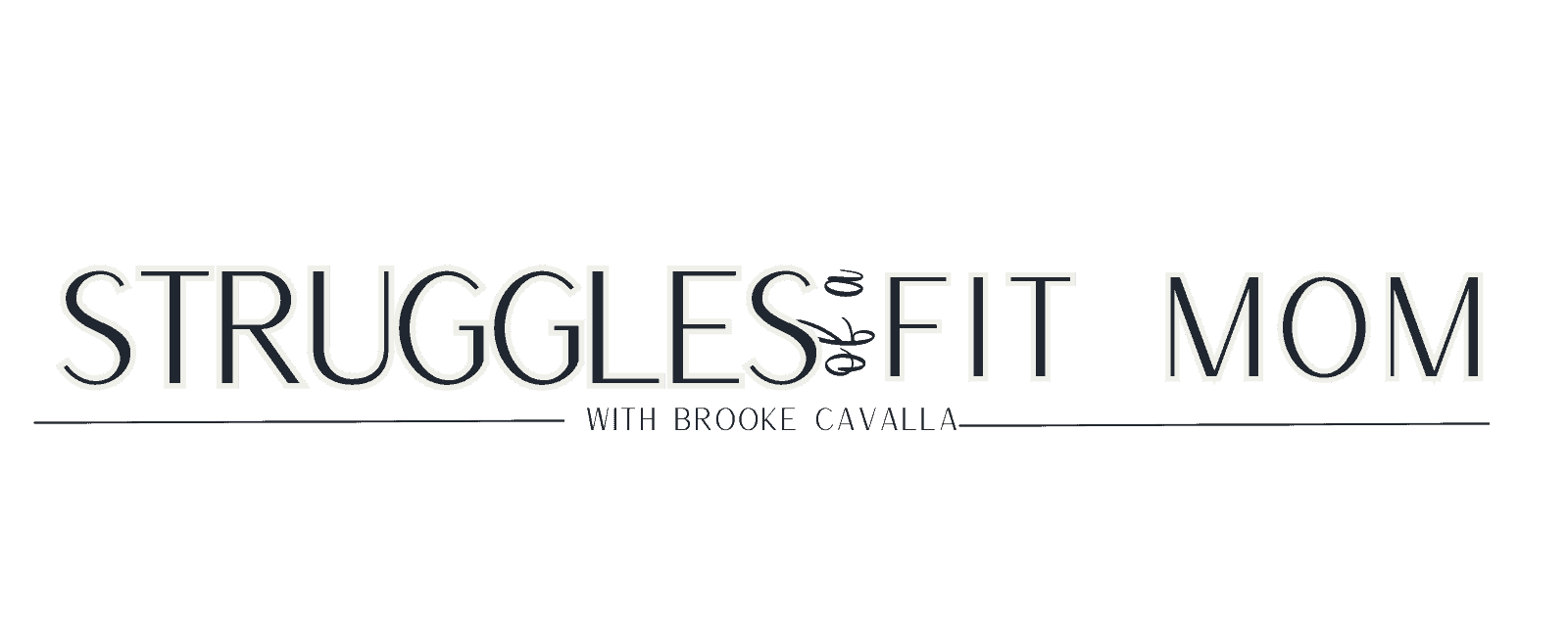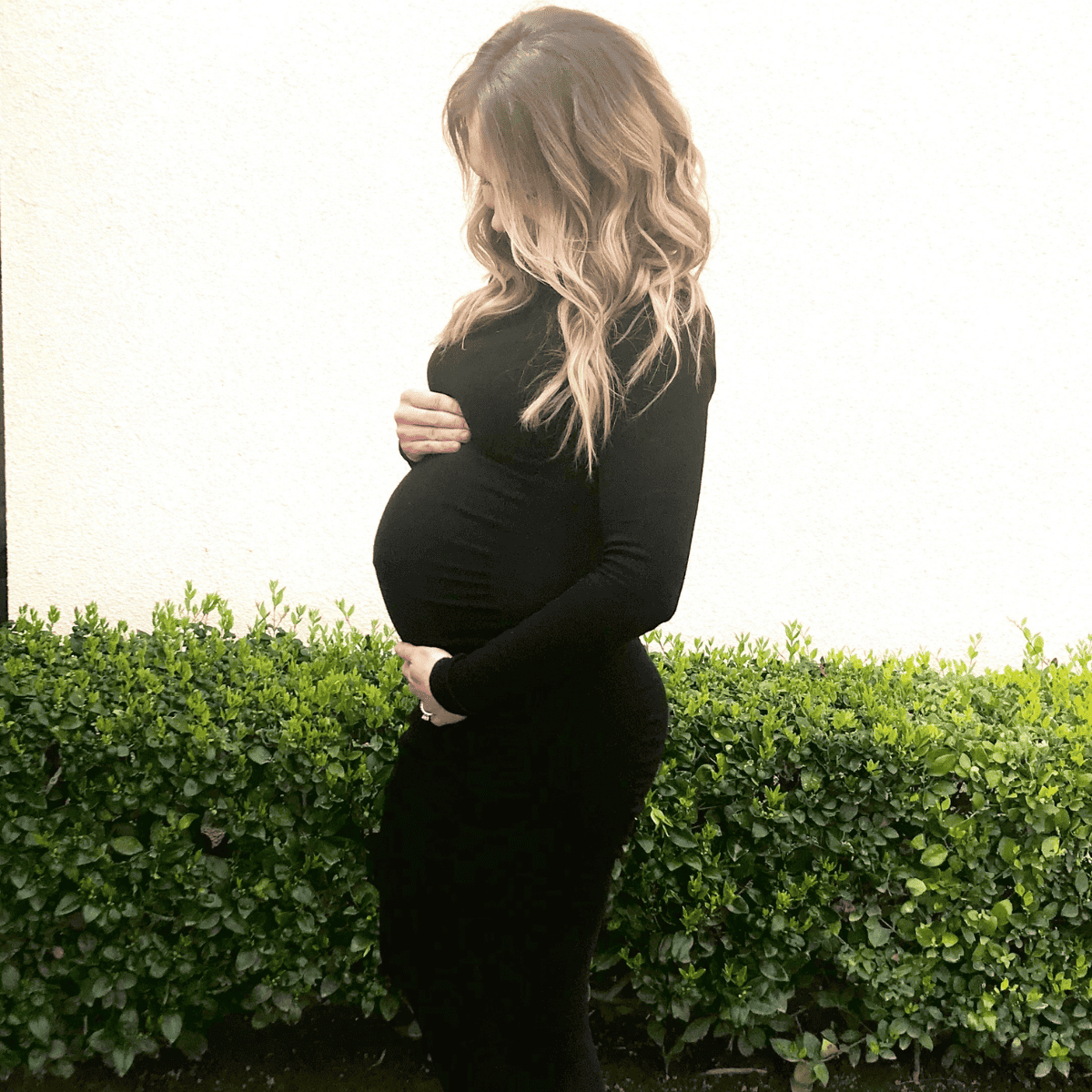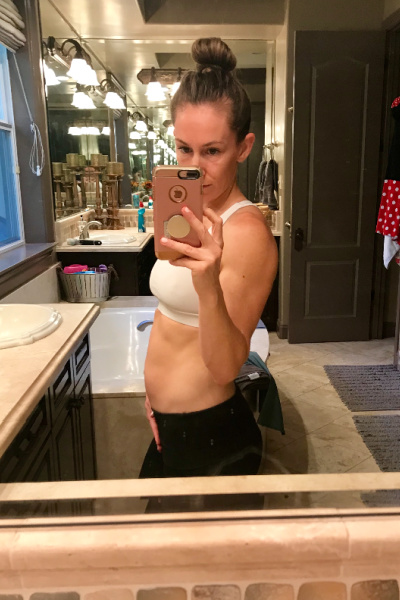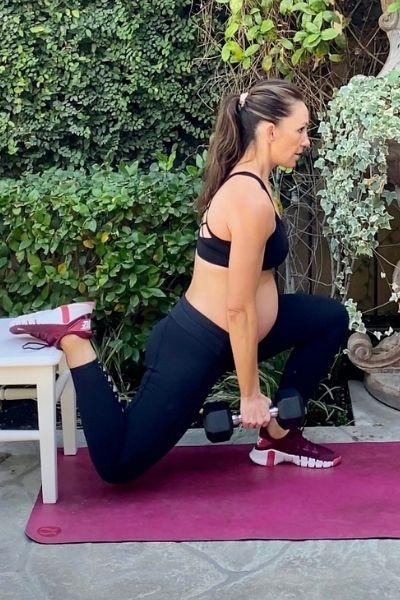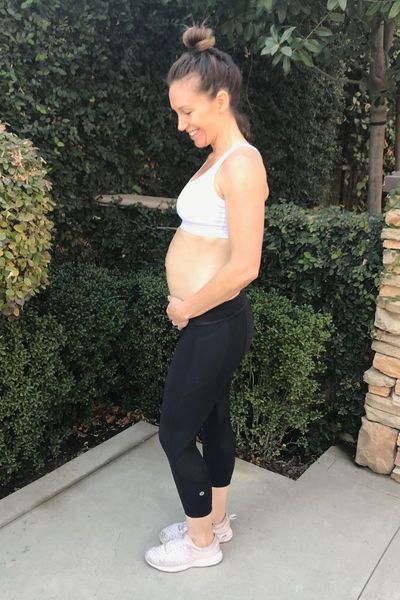Yes, You Can Do Planks During Pregnancy! Here’s How
To plank or not to plank? That dilemma is what brought you here, right?
You’ll probably find several different opinions on plank exercises during pregnancy.

But if you think about it, saying “no” to planks is also saying know to exercises like push-ups, burpees, renegade rows, and yoga poses like Chaturanga.
So instead of completely squashing planks or any exercise during pregnancy, I like to look at it in a little more comprehensive way to see if they are a good fit for YOU and YOUR pregnancy.
Now, with that said, planks are definitely a no-go as your belly grows, but don’t worry, I am going to teach you exactly what you need to know about planking and exercises that involve planks during pregnancy!
Today you will learn:
- How planking affects the core
- Is it safe to do planks during pregnancy?
- Should you do planks during pregnancy?
- The benefits of a strong core during pregnancy
- When to start modifying planks or exercises that involve planks
- The best plank variations for each trimester
How Does Planking During Pregnancy Affect My Core?
By the end of the first trimester or into the second trimester, your abdominal muscles begin to stretch and separate to make room for the growing baby.
The thin connective tissue called the “Linea Alba” that holds our abdominal muscles together begins to stretch in order to make room for the baby.
As the ab muscles stretch during pregnancy, they become progressively weaker.
Think of a rubber band being stretched. The greater the stretch, the weaker it becomes.
This means it becomes much more challenging to maintain proper core engagement, especially in exercises such as planks which require a lot of core strength.
We want to avoid exercises that place extra pressure on the thin connective tissue to avoid worsening the natural process of abdominal separation leading to a greater Diastasis Recti.
Diastasis Recti is simply abdominal separation and it is completely normal, natural and NECESSARY.
While it is nothing to fear, it is something to be aware of because we don’t want to do things that could potentially make it worse, like planks.
Is It Safe To do Planks During Pregnancy?
Planks are a prenatal exercise that is VERY unlikely to hurt your baby.
It is not an exercise that will significantly elevate your heart rate or cause you to get overheated or breath heavily.
However, if done without proper core engagement and function, they could potentially leave you with some back pain and/or greater abdominal separation.
When trying to decide if ANY exercise you want to do during pregnancy is safe, you need to differentiate between “can you do the exercise” and “should you do the exercise“.
“Can” you do the exercise means that you are physically capable of doing it.
“Should” you do the exercise means that you can do the exercise but not with perfect form and risk injury to your body.
This means that sure, you might be able to do planks or burpees but SHOULD you do them based on possible risk of injury to your body?
Let’s find out!
As a general rule of thumb, planks and most other exercises or workouts are safe during pregnancy IF:
- You can do them correctly
- Your have been doing them before pregnancy
- You have received the green like from your doctor to exercise during pregnancy.
Keep in mind that planks are not risky for your baby.
However, if done incorrectly, they could potentially have some painful side effects for you such as back pain or greater abdominal separation.
Should You Do Planks During Pregnancy?
Here are some general guidelines to determine whether planks are safe for you and YOUR pregnancy.
Yes
- You are in the first 16-20 weeks of pregnancy.
- You were physically active prior to pregnancy and are familiar with doing planks correctly
- You do not have any medical complications or contradictions to prenatal exercise
- You have been given the green light to exercise by your health care provider.
- You do not experience any pain doing planks or plank like exercises.
Maybe/No
- You are past 17 weeks of pregnancy
- You notice any coning, bulging or doming of your core during an exercise
- You have a weak core or already have an unhealed Diastasis
- This is not your first pregnancy
- You have been told by your health care provider not to exercise during pregnancy
- You feel pain when doing planks or plank like exercises.
What Are The Benefits of Core Training During Pregnancy?
I find many moms really underestimate the importance of having a strong core during pregnancy.
A strong core that maintains proper strength AND function during pregnancy can prevent problems down the road.
A strong core during pregnancy will help:
- reduce back and/or pelvic pain
- carry your baby and belly more comfortably
- help you push more efficiently during delivery
- -recover faster postpartum
When Should You Start Modifying Planks During Pregnancy?
Abdominal stretching does not occur until the baby and uterus start to grow.
This may look a little different for everyone and even with different pregnancies.
My tummy was “sticking out” much more and faster with my third pregnancy. This meant I had to be more careful with exercises like planks.

I suggest checking for any abdominal separation toward the end of your first trimester and at the beginning of your second trimester.
You should start modifying planks and any exercise if you notice any coning or feel extra pressure on the midline of your tummy or pressure on your pelvic floor.
Exercises such as push-ups, burpees, renegade rows or yoga poses like Chaturanga all place you in a plank position.
How to Modify Planks During Pregnancy
Before we jump into planking during pregnancy, I want you to focus on maintaining proper pelvic alignment and use your core to prevent an anterior pelvic tilt.
When performing planks, an anterior pelvic tilt prevents proper core engagement which can lead to back pain or too much pressure on the connective tissue in your core.
To prevent an anterior tilt, think squeezing your glutes, think zipping up your your lower abs, NOT sucking in.
Imagine wearing a corset and how it stabilizes your core and mimic that same stabilization with your core muscles.

The Best Plank Modifications During Pregnancy
The first trimester is the best time to start focusing on core strength because you can do most traditional core exercises at this point, or until you see your baby growing.
If you are relatively new to core work, you can jump to the second and third trimester modifications.
Detailed Exercise Instructions:
Knee Hover Planks
(Safe for all trimesters)
- Start on your hands and knees with your wrists directly under your shoulders and hips stacked over your knees.
- Exhale and on the inhale zip your lower abdomen up and imagine using your core to slightly lift your knees about 1-2 inches off the ground.
- Stay in this top position on your tippy-toes for 3-5 seconds then lower.
Notes on form
- Avoid arching your back. Think cat position in cat/cow.
- Focus on keeping your shoulder blades down away from your ears.
Planks
(Best for first trimester and possibly beginning of second trimester)
This can be done on your forearms or elevated on your hands. An elevated plank is a little more challenging.
- Engage your core and start in the top of a push-up position.
- High plank form set up: your hands should be directly under your shoulders, your shoulder blades pulled down away from your ears and your feet can be together or shoulder width apart.
- Focus on squeezing your glutes, core and quads to keep your body in a straight line. You don’t want your back to arch down toward the ground or your but up in the air.
- As soon as you feel yourself lose form, relax for a few breaths then continue.
Knee to Elbow Plank
(Best for first trimester and possibly beginning of second trimester)
- Engage your core and being in the plank position as described above.
- Bend your right knee and bring it up toward your left forearm. Keeping your core engaged, move your knee to your right forearm then back to the plank position.
- Repeat on the opposite side, resting or readjusting in between as needed.
- Make sure you are not arching your low back by keeping your core strong.
Side Plank
(Safe for all trimesters with modifications if needed)
- Start in a side laying position on your forearm with your elbow directly under your shoulder. Do not let that shoulder creep up to your ears!
- Engage your core and lift your hips off the ground so you are in a straight line from your head to toes.
- You can stack your feet on top of each other or have the top foot slightly behind the behind the bottom foot.
- Now focus on squeezing your obliques and glutes to keep your hips elevated.
- You want to avoid your top hip from rotating backwards by keeping your core engaged. Think pelvis to ribcage.
- If you are new to planks or further in your pregnancy, you can modify by dropping your bottom leg and bending your knee.
Up-Down Plank
(Safe for the first trimester and beginning of the second trimester with proper core engagement)
This exercise may look easier than it is but there are many things to focus on when doing the up-down plank. It will challenge your core and your arms.
- Start in the plank position with your core and glutes firmly engaged.
- Next you are going to transition to a low plank by dropping your right elbow, then your left.
- Push yourself back up onto your right elbow then left. Alternate which side lowers each time.
- The goal of this exercise is to keep your core, quads and glutes engaged to prevent your hips from swaying side to side, sagging or piking your booty in the air.
- To modify, you can spread your feet a little further apart for more stability.
Elevated Plank Rocks
(safe for all trimesters)
- Start in the plank position with your hands elevated onto a chair or sturdy bench.
- Engage your core and slowly rock your body forward. Hold in this forward position for 3-5 seconds then rock your body back to the starting position.
- As you move forward, your core will want to disengage. Focus on holding it strong and do not let your hips sag.
Elevated Mountain Climbers
- Start in the plank position with your hands elevated onto a chair or sturdy bench.
- Engage your core and slowly draw your right knee up toward your chest.
- Return to the plank position the repeat on the left leg, keeping your core engaged the entire time.
- Imagine literally using your core to bring your knee to your chest.
- Continue back and forth for the duration of the interval or reps.
Side Plank Crunch
(Safe for first trimester in the traditional side plank position. The modified version is safe for all trimesters.)
- Starting in the side plank position, either standard or modified.
- Lift your top arm and leg and crunch your knee toward your elbow.
- Return to the side plank position then repeat for the duration of the interval or reps. Then switch sides.
- The key is to keep those hips elevated off the floor by engaging the bottom oblique and glute.
Side Plank Leg Lift
- Begin in the side plank position as described above.
- Keeping your core and bottom glute activated, slowly lift and lower your top leg.
- Focus on keeping your hips from sagging as you move your leg.
To The Floor Pushup
(safe for the first trimester)
- Start in the pushup position with your core activated.
- Slowly bend your elbow and lower your body to the floor. Your hands should be right outside your chest.
- Once you are completely flat on the ground, activate your core and push yourself up.
- Modify on your knees as needed.
Reverse Plank
This is one of my favorite prenatal core exercises!
(safe for all trimesters)
- Start by sitting on the floor.
- Stretch your legs out in front of you and place your hands on the ground behind you. You can have your fingers pointing forward or back depending on flexibility.
- Activate your core and squeeze your glutes to lift your hips up off the ground.
- Keep your gaze forward and shoulders away from your ears.
- You can move up and down or hold at the top, both are great variations!
Are Planks During Pregnancy Safe If You Have Diastasis Recti?
If you are not on your first pregnancy and have an unhealed diastasis, then I would recommend avoiding planks until you regain proper strength and function.
Final Words On Planks During Pregnancy
While many things you read these days may have you freaked out about Diastasis Recti or ab exercises during pregnancy, keeping your core strong during pregnancy is one of the best things you can do.
There are certain exercises like leg lifts or crunches that should be avoided but there are also plenty of great alternatives including these plank variations!
Struggles of a Fit Mom uses only high-quality sources, including peer-reviewed studies, to support the facts within it’s articles. Read my editorial process to learn more about how I fact-check and keep my content accurate, reliable, and trustworthy.
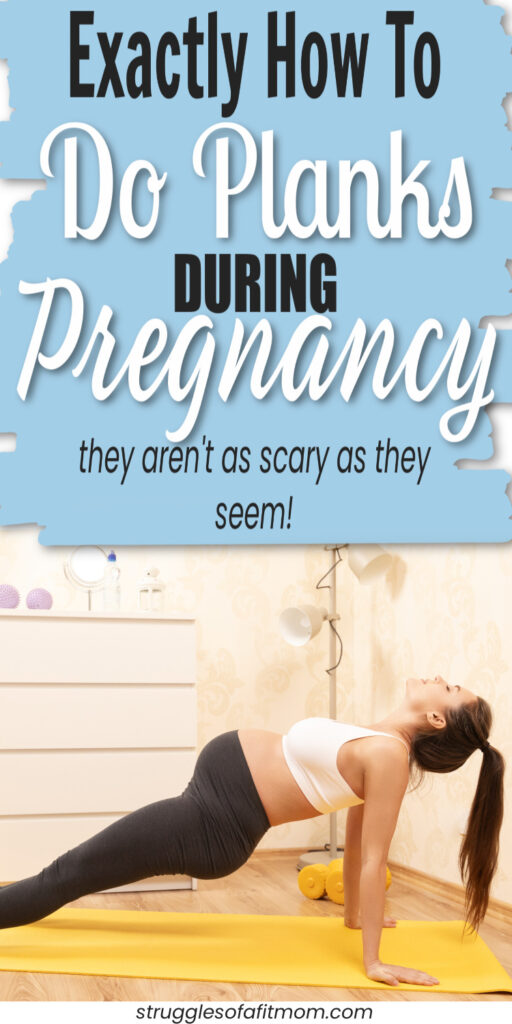

Brooke is a certified Prenatal and Postnatal Exercise Specialist with a Bachelors of Science degree in Kinesiology-Exercise Science. She is also a mom of 3 girls with more than 15 years of experience in health and fitness. Brooke’s goal at Struggles of a Fit Mom is to help motivate, educate and inspire other busy mamas who struggle with finding time, energy and motivation to take care of themselves in the chaos of motherhood.

